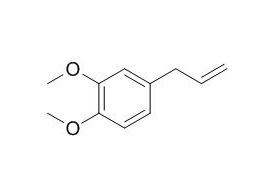Methyleugenol
Methyleugenol (ME) is a natural constituent of the essential oils of a number of plants widely used in foodstuffs as flavouring agents, in view of the carcinogenic potential of ME, the need to check its presence in food products with effective analytical methods. ME has elaxant and antispasmodic actions on guinea-pig isolated ileum, it also has antinociceptive, anti-inflammatory, and insecticidal properties.ME can inhibit the production of nitric oxide and decreased the protein expression of inducible nitric oxide synthase, it down-regulates the production of pro-inflammatory cytokines in the ischemic brain as well as in immunostimulated mixed glial cells.
Inquire / Order:
manager@chemfaces.com
Technical Inquiries:
service@chemfaces.com
Tel:
+86-27-84237783
Fax:
+86-27-84254680
Address:
1 Building, No. 83, CheCheng Rd., Wuhan Economic and Technological Development Zone, Wuhan, Hubei 430056, PRC
Providing storage is as stated on the product vial and the vial is kept tightly sealed, the product can be stored for up to
24 months(2-8C).
Wherever possible, you should prepare and use solutions on the same day. However, if you need to make up stock solutions in advance, we recommend that you store the solution as aliquots in tightly sealed vials at -20C. Generally, these will be useable for up to two weeks. Before use, and prior to opening the vial we recommend that you allow your product to equilibrate to room temperature for at least 1 hour.
Need more advice on solubility, usage and handling? Please email to: service@chemfaces.com
The packaging of the product may have turned upside down during transportation, resulting in the natural compounds adhering to the neck or cap of the vial. take the vial out of its packaging and gently shake to let the compounds fall to the bottom of the vial. for liquid products, centrifuge at 200-500 RPM to gather the liquid at the bottom of the vial. try to avoid loss or contamination during handling.
Biomedicines.2020, 8(11):486.
Kyung Hee University2024, rs-3888374
Molecules.2020, 25(23):5636.
Advances in Traditional Medicine 2021, 21:779-789.
Applied Biological Chemistry2022, 65(12)
Food Chem Toxicol.2023, 176:113785.
Trop J Nat Prod Res2023, 7(12):5611-5615.
Biomed Pharmacother.2024, 179:117395.
Pharm Biol.2016, 54(7):1255-62
Antioxidants (Basel).2021, 10(9):1487.
Related and Featured Products
Free Radical. Res., 2010, 44(8):925-35.
Methyleugenol reduces cerebral ischemic injury by suppression of oxidative injury and inflammation.[Pubmed:
20815773 ]
METHODS AND RESULTS:
The present study tested the cytoprotective effect of Methyleugenol in an in vivo ischemia model (i.e. middle cerebral artery occlusion (MCAO) for 1.5 h and subsequent reperfusion for 24 h) and further investigated its mechanism of action in in vitro cerebral ischemic models. When applied shortly after reperfusion, Methyleugenol largely reduced cerebral ischemic injury. Methyleugenol decreased the caspase-3 activation and death of cultured cerebral cortical neurons caused by oxygen-glucose deprivation (OGD) for 1 h and subsequent re-oxygenation for 24 h. Methyleugenol markedly reduced superoxide generation in the ischemic brain and decreased the intracellular oxidative stress caused by OGD/re-oxygenation. It was found that Methyleugenol elevated the activities of superoxide dismutase and catalase. Further, Methyleugenol inhibited the production of nitric oxide and decreased the protein expression of inducible nitric oxide synthase. Methyleugenol down-regulated the production of pro-inflammatory cytokines in the ischemic brain as well as in immunostimulated mixed glial cells.
CONCLUSIONS:
The results indicate that Methyleugenol could be useful for the treatment of ischemia/inflammation-related diseases.
Eur. J. Pharmacol., 2006, 553(3):99-103.
Antinociceptive effect of methyleugenol on formalin-induced hyperalgesia in mice.[Pubmed:
17049512 ]
METHODS AND RESULTS:
The effects of Methyleugenol, an essential oil isolated from Asiasari radix, on antinociception were examined using the formalin test in mice. Oral administration of 10 mg/kg Methyleugenol significantly decreased the duration of licking and biting behavior in the second phase without affecting that of the first phase, as did diclofenac, a non-steroidal anti-inflammatory drug. Methyleugenol also inhibited pain-related behaviors induced by intrathecal injection of N-methyl-d-aspartic acid (NMDA), while diclofenac did not affect these behaviors. These effects of Methyleugenol were suppressed by bicuculline, a gamma-aminobutyric acid(A) (GABA(A)) antagonist. Muscimol, a GABA(A) agonist, displays the same action as Methyleugenol with respect to the formalin test and NMDA-induced behaviors. Methyleugenol did not affect cyclooxygenase-1 and -2 activities.
CONCLUSIONS:
These results suggest that the antinociceptive effect of Methyleugenol on the second phase of formalin-induced pain may be due to the inhibition of NMDA receptor-mediated hyperalgesia via GABA(A) receptors.



